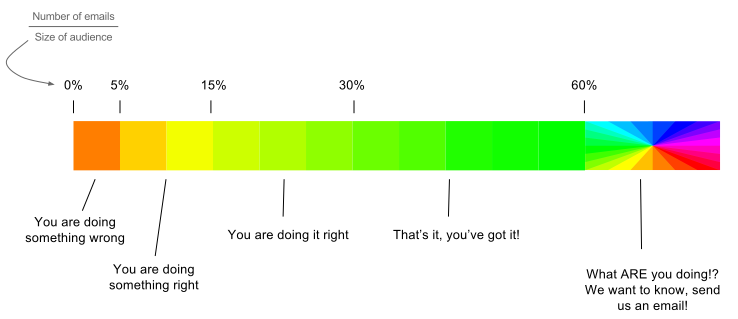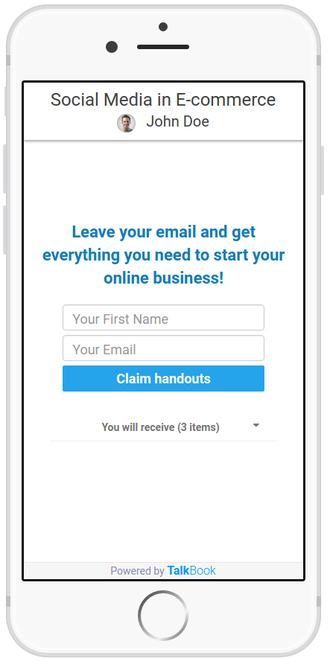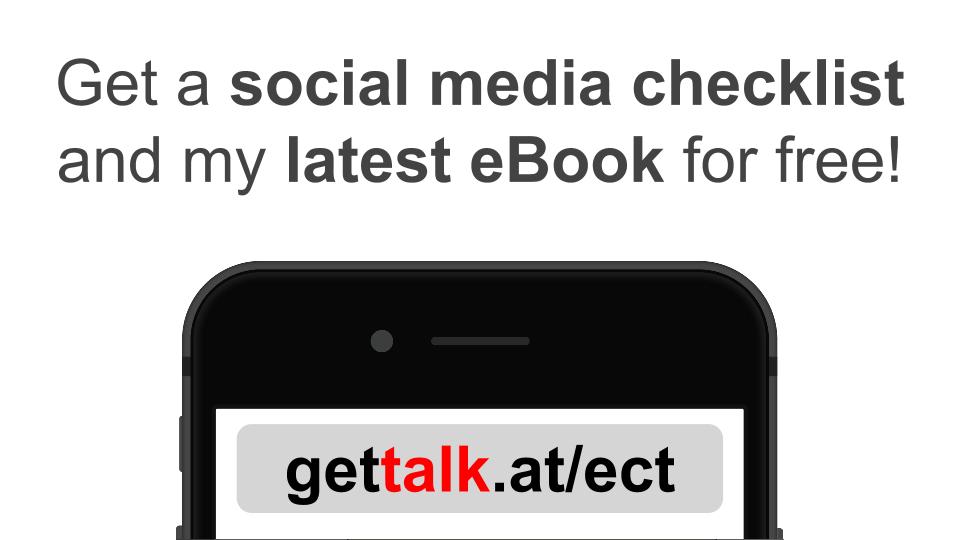
Professional Speaker's Guide to Collecting Email Addresses From the Live Audience Using a Web Page
Your first time: not what you expected
You heard about this awesome method of collecting audience email addresses using a specialized web page, and you can’t wait to try it out and say goodbye to handling all those business cards and printing out and carrying tons of paper forms.
The idea is simple: create a web page with signup form tailored for your next talk, share the link with your audience at the end of the talk and enjoy the email addresses later.
On the wings of excitement you get somebody to create you a web page for your next talk (or you do it yourself if you are a techie), then get a designer to polish it (or you do it yourself if you are also an artistic soul), and before you know it, you just gave a dazzling talk in front of 100 people and asked them to connect with you by leaving their email on your awesome new web page!
Finally, after getting some rest after the talk, you open up your laptop and check the list of email addresses that you collected. There are 4 email addresses on the list. You rub your eyes, adjust the glasses, cross the fingers - it is still 4. How is that possible!? What went wrong? Treacherous technology!
We do not want you to give up on all technology, so we talked to the professional speakers that are successfully using web pages to collect email addresses and compiled a list of best practices to follow while doing it. Read on to turn that 4 into 40!
Best practices
While the concept of collecting email addresses via a web page is fairly simple, there are still many places for a mistake if you are just starting out. That is why we made a list of best practices by talking to experienced professional speakers who successfully use this method.
Special thanks to Lisa B. Marshall (author of The Public Speaker Podcast) and Helene Segura for providing invaluable advice and insights into their practices!
Keep the web page simple
The audience already knows a lot about you and what you do, so there is no need to crowd the web page with your bio and general information, especially not with the information that you just delivered through your talk. Give them a clear course of action - put an email address input field in front of them, with a short explanation why they should leave their email address.
Offer value (handouts) to your audience
Offer them something in exchange for their email address. Not only is this a great way to incentivize them to leave an email address, but they also have something of yours to play with later, that will remind them of you. That could be a simple cheat sheet, free eBook, link to your video or discount on one of your products.
Slides from the talk (a.k.a. poor man’s handouts) are also an option, but keep in mind that they have already seen them. If you are going with the slides, try to be creative: add few special, not yet seen slides, or add special extra notes to the slides, kind of like “author’s edition”. Now that is much more exciting!
Use short link (yes, size does matter!)
“Now, please take out your smartphone and go to http://www.mypersonalwebpage.com/freeitems/cheatsheet to get a free cheat sheet.” - if somebody actually types that into their smartphone and leaves you an email, you can be sure that they are crazy in love with you! However, if you would also like to collect emails from the rest of the audience, you need that link to be short and easy to type, something like gettalk.at/ect. If you can not obtain such a short link with your current setup, you can shorten your existing link using URL shorteners, like bitly.com and goo.gl.
Tip: there is no need for “http://” in the link, and for most pages you can also omit the “www.” prefix if there is one.
Make the link visible
Put the link on the last slide of your presentation and make sure that it is easy to read. Same as with the web page, keep the slide simple. Don’t crowd your slide with your email address, Twitter, Facebook, LinkedIn, home address, social number and pants size, because your audience will not know what you want them to focus on!
Also, don’t put the link in the corner of the slide, or make it too small - the link has to dominate the slide.
Give your audience enough time
Make sure that you keep the slide with the link visible long enough. Having short and memorable link will help, but they still need some time to take out their smartphones and type it in.
Guide your audience through it
Go with them through the process, step by step. Tell them to take out their phones, wait for them to do it, and then tell them to open their browsers and type the link. Wait a little bit more, and then tell them to enter their information - you can even show a slide with the screenshot of your web page so that they know they got it right.
You may think that they do not need your guidance, but this approach can greatly increase the number of collected email addresses!
Share the link multiple times
Instead of sharing the link with them only once, on the last slide, you can do it on multiple occasions:
- Before the event - Ask the event organizer to put the link in the pre-event email or on the event web page.
- Just before the talk - Ask the host of the event to announce your web page. Lisa B. Marshall tells them to say it like this: “If you haven’t gotten the handouts yet, please use your phone to visit {{your web page link here}} to get a copy of the handouts and bonus materials that our speaker has provided.”.
- During the talk - When the moment is right, you can mention the extra materials that they will be able to get later so that you prepare them for that moment at the end of the talk.
- At the end of the talk - Most important step. Display the link on the last slide and ask them to leave their email. Clearly state what they will get for leaving their email.
- After the event - Ask the host to put the link in a follow-up email. You may also share the link on social networks, and if you are doing it on Twitter, make sure to include the event hashtag.
Align the offer with your talk
Make sure that the content you are offering in exchange for email addresses is aligned with your talk. Of course, you are not going to offer them your latest sushi cookbook if you are talking about social media marketing, but the type of the content that you are offering can also have a big impact.
For example, giving them a discount on your most expensive product may not work well if they are not yet ready to buy it. Instead, you could offer them a free, short eBook which will get them further hyped up about your product, and you can give them a discount on the product later. On the other hand, sometimes an eBook is also too much, so you may offer a cheat sheet instead, which demands them to invest much less time in consuming it.
Analyze and improve
Numbers don’t lie! Collect the data for each of your talks: how big was the audience, how many people visited your web page for that talk, how many email addresses have you collected.
If you can also keep the log of what your web page looked like for each talk, you can compare performance among the talks and see what works best!
For example, on few of your talks, you may try offering a free eBook, while on the next few you can try offering a free cheat sheet. After that, you can grab that numbers, do some analysis and see if you should continue with the cheat sheet, eBook, or try something different.
Advanced tricks (don’t try this at home)
Hands up
Just before sending the audience to your web page, open with: “If you would like to get my eBook, please raise your hand.”. When they do so, continue with “Ok, now everybody that raised your hand, please take your phone and leave your email address on this link”.
This is such a great method: first you make it really easy for them to get that free item (they just have to raise their hand), plus they do not want to miss out on it since other people around them are also raising their hands. Then you ask them to do somewhat more complicated action, but they already committed to going for that free item, so they are more likely to do it.
Scarcity
Oldie but goldie - tell your audience that this is a one time offer and that they can download your free content only today.
What should I expect?
You applied some of the best practices, and you are starting to be proud of the number of emails that you are collecting. However, you also started thinking dark thoughts. What if everybody else is collecting more emails than me? Maybe they are laughing at me behind my back? Or what if I am actually doing much better than others, but am missing an opportunity to brag about it?
To set you at ease, we created a simple success meter based on how other speakers are doing!

What you really want is to get in that area above 15%. Try using best practices that we explained above, and you can also just send us an email and we will take a look at your process!
Conclusion
Although the basic idea of collecting emails from your audience using a web page is simple, execution and the details can make a big difference in the number of emails you collect.
Keep in mind that the method itself may not be a good fit for every kind of talk and type of the audience, so keep testing and trying out what works best for you (check our blog post to learn about other ways to collect email addresses from your audience).
Also, do not forget to check with your client that it is ok to collect emails.
What are the tips and tricks you are using when collecting email addresses from your audience using a web page? Share them in the comments!


